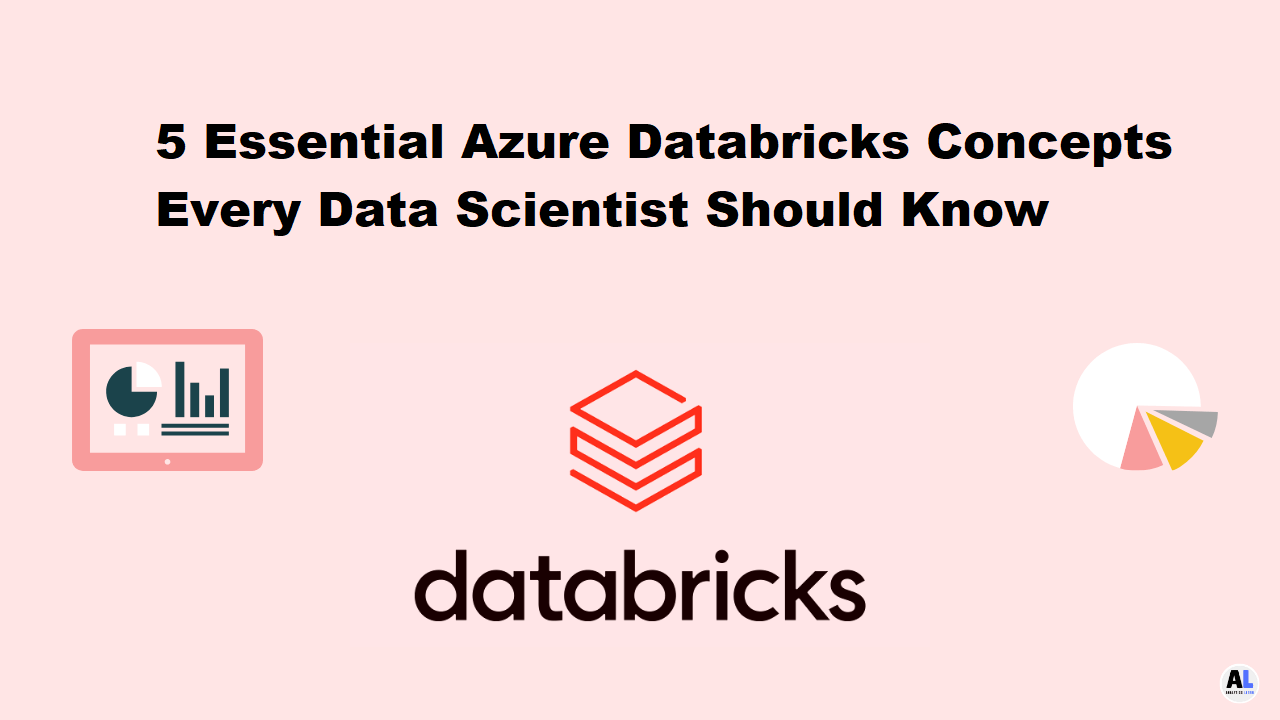5 Essential Azure Databricks Concepts Every Data Scientist Should Know

Introduction
Azure Databricks is a big data analytics and machine learning platform hosted in the cloud. It offers a centralized workspace for managing and scaling large data workloads. Notebooks, clusters, jobs, libraries, data sources, and collaboration tools are all important concepts. Notebooks are live documents that contain code, data, and visualizations. Clusters are groups of virtual machines that work together to process workloads. Tasks are scheduled and triggered by jobs. Libraries are collections of packages and dependencies that can be used in notebooks and Spark applications. Azure Blob Storage, Azure Data Lake Storage, and Azure SQL Database are all data sources. Sharing notebooks, version control, and integration with third-party tools are all collaboration features.
Table of Content
- Introduction
- Concepts every data scientist should know
- Exploring and Analyzing Big Data with Interactive Notebooks
- Cluster Administration for Efficient Big Data Processing
- Managing Dependencies and Packages in Libraries
- Using Different Data Sources in Azure Databricks
- Conclusion
Concepts every data scientist should know
- Interactive Notebooks: Interactive notebooks are a key concept in Azure Databricks that allow data scientists to explore and analyze large amounts of data using various programming languages such as Python, R, and SQL. Notebooks enable the development, testing, and sharing of code and visualizations in a collaborative and interactive environment.
- Clusters: In Azure Databricks, clusters are virtual machines processing data and performing machine learning tasks. Data scientists should be able to create, configure, and manage clusters to optimize performance and handle a variety of workloads.
- Libraries are essential in Azure Databricks because they allow data scientists to manage dependencies and packages needed for notebooks and Spark applications. Libraries contain third-party packages, modules, and jars that extend Azure Databricks' functionality.
- Jobs: Azure Databricks' Jobs feature allows data scientists to schedule and automate tasks like running notebooks and Spark applications. Jobs can be scheduled to run at certain times or triggered by an event or condition.
To gain complete knowledge about Azure Databricks Azure Databricks Training helps to a great extent.
Exploring and Analyzing Big Data with Interactive Notebooks
Interactive notebooks are an important part of Azure Databricks, as they provide a collaborative and interactive environment for exploring and analyzing big data. Data scientists, analysts, and engineers can write and execute code, visualize data, and document their work in one place.
Notebooks support various programming languages, including Python, R, SQL, and Scala, making working with various data sources and frameworks simple. Users can create interactive charts, graphs, and dashboards using built-in visualizations and third-party libraries.
Notebooks support real-time collaboration and version control, allowing multiple users to simultaneously work on the same document and track changes over time. This makes Azure Databricks a powerful data analysis and exploration platform by facilitating efficient teamwork and knowledge sharing..
Cluster Administration for Efficient Big Data Processing
- Cluster management is an essential component of Azure Databricks for effective big data processing. Clusters are collections of virtual machines that work together to process data and perform machine-learning tasks. Azure Databricks provides various types of clusters with varying sizes and configurations to handle various workloads.
- Cluster management entails creating, configuring, and terminating clusters as needed. Users can optimize cluster performance by adjusting the number of nodes, CPU and memory allocation, and other settings. Azure Databricks also includes auto-scaling capabilities for dynamically adjusting cluster size based on workload demands.
- Azure Databricks includes logging and metrics to help you monitor and troubleshoot cluster performance. Users can also integrate with third-party monitoring tools to better understand cluster performance and identify potential problems.
- Effective Azure Databricks cluster management can significantly improve big data processing efficiency, lower costs, and boost productivity.
- Task Scheduling and Automation
- Jobs are an important feature of Azure Databricks that enable users to schedule and automate tasks like running notebooks and Spark applications. Jobs can be scheduled to run at certain times or triggered by an event or condition.
- Users can schedule jobs to run on specific clusters with predefined parameters such as node count and machine type. Jobs can also be configured to run on different clusters based on workload demands or resource balancing.
- Azure Databricks provides several features for monitoring and managing jobs, including job status tracking, alerting, and logging. Users can also configure dependencies and retries for jobs to ensure they are completed successfully.
- Furthermore, Azure Databricks supports various job types, including notebook jobs, Spark jobs, and REST API jobs. Users can use this to perform data ingestion, processing, and model training tasks.
Effective job scheduling and automation in Azure Databricks can boost productivity, reduce manual effort, and ensure task execution is consistent and reliable.
Managing Dependencies and Packages in Libraries
Libraries are an important part of Azure Databricks because they allow users to manage dependencies and packages for notebooks and Spark applications. Libraries contain third-party packages, modules, and jars that are used to extend Azure Databricks' functionality.
- Two types of libraries are available in Azure Databricks: cluster-scoped libraries and global libraries. Cluster-scoped libraries are installed on a single cluster and are accessible only to notebooks running on that cluster. All notebooks and Spark applications have access to global libraries installed across all clusters.
- Users can install libraries from various sources, including PyPI, CRAN, and Maven. Users can also install, update, and uninstall libraries using the built-in library management interface in Azure Databricks. Users can also configure library dependencies and conflicts to ensure notebooks and Spark applications run smoothly.
- In addition, Azure Databricks provides library management and monitoring features such as library versioning, auto-installation, and library usage tracking. These features allow users to ensure that notebooks and Spark applications run consistently and reliably.
Effective library management in Azure Databricks can boost productivity, reduce errors, and allow faster data pipeline, model development, and experimentation.
Using Different Data Sources in Azure Databricks
- Azure Databricks supports various data sources and integrations, allowing users to ingest, process, and analyze data from various systems and applications. Cloud storage providers, databases, streaming platforms, and data integration tools are among the integrations available.
- Azure Databricks supports native integrations with cloud storage providers such as Azure Blob Storage, Amazon Web Services S3, and Google Cloud Storage. This allows users to easily store and access large amounts of data while remaining scalable and cost-effective.
- Azure Databricks also works with various databases, including Azure SQL Database, PostgreSQL, and MySQL. Users can query, ingest, and export data from these databases.
- Furthermore, Azure Databricks integrates with popular streaming platforms like Apache Kafka and Azure Event Hubs. This allows users to process and analyze real-time data streams and create real-time analytics applications.
- Azure Databricks also integrates with data integration tools like Azure Data Factory and Apache NiFi. Users can build end-to-end data pipelines and automate data processing and analysis workflows.
Effective data source integration in Azure Databricks allows users to gain insights from various data sources, improve data quality and consistency, and boost productivity and collaboration.
Conclusion
Azure Databricks is a robust data analytics and machine learning platform that allows data scientists to create scalable, dependable, and performant data pipelines and models. Data scientists can perform tasks such as data exploration, processing, analysis, and modeling using interactive notebooks, clusters, libraries, jobs, and data source integrations. Azure Databricks provides a collaborative and user-friendly environment for teams to collaborate on projects, share code, and work together. Azure Databricks is a comprehensive and flexible platform for modern data analytics and machine learning workflows, thanks to its integration with Azure cloud services and various third-party tools.
Author Bio
Bala SubbaRao Kunta is a technical content creator who works for Mindmajix. He is passionate about technology and possesses an interest in writing content that relates to the latest technologies like IOT, AI, Devops, Machine Learning, and Data Science. In his free time, he likes playing cricket.





